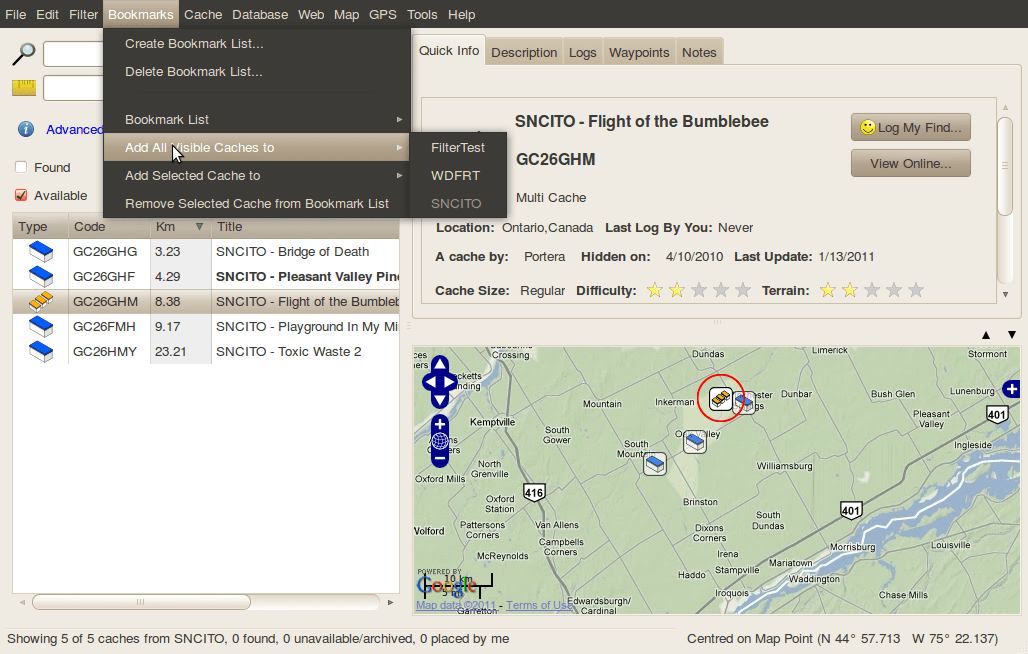

Show track statistics (distance, time, elevation): Segment break threshold for plain-text track data: secondsĪdd artificial timestamps (e.g., for OSM or Garmin Connect): Preserve track styles in input files (e.g., from KML or Garmin GPX): gpsbabel -i gpx -f wayiii.gpx -f wayrino.gpx \ -x radius,distance5M,lat40.75,lon-119.25 \ -o gpx -F merge. Threshold (in meters) for re-ordering/merging tracks: sed 's/gpxdata://g' IN.gpx > OUT.gpx Include points within radius filter This command takes two GPX files as input and then outputs those waypoints within 5 miles of 40.75N, 119.25 W into the GPX file merge.gpx. (GPSBabel also has a wider range of output formats.)
#Gpsbabel output to gpx zip#
If, however, you have ZIP codes, postal codes, or cities & states, this form is the right tool to use - but be sure to include a valid header row! (See the waypoint tutorial for more info.) Addresses: If you want to find the coordinates of a list of street addresses, it may be easier to use the geocoding utilities.This form reads a tracklog or waypoint file (in a recognized format) or plain-text tabular data, and converts it to an easy-to-read tab-delimited or CSV text file, or to a GPX file. 16% of the original size with sufficient resolution of the route for the homepage.No ads? No problem! You can support GPS Visualizer by making a donation with PayPal instead. This reduces the size of the file again to 58kB and thus to approx. The GPSBabel command is simple: gpsbabel -i TypeOfInputFile -f NameOfInputFile -o TypeOfOutputfile -F NameOfOutputfileįor my example file with 2011_HM_Gyeongju_latlon.gpx (69.2kByte) I choose two filters, one to “simplify” the route and one to limit the number of points to 1,050: gpsbabel -i gpx -f 2011_HM_Gyeongju_latlon.gpx -x simplify,count=1050 -o gpx -F 2011_HM_Gyeongju_latlon_2100p.gpx Assuming that you run steadily, you could for example for a half marathon (21,000 meters) represent a point every 20 meters. If you want to show a run over several hours on a map, you will not need a point every 5 seconds of the run. Adapt the number of points in the GPX file using GPSBabel Compared to the input file 2011_HM_Gyeongju.gpx with 341.7kByte, this is already a reduction to 20% of the file size.
#Gpsbabel output to gpx code#
To apply this code to the GPX file we simply use the XSLT service from online-toolz and enter its input file in the left column, the code in the right column and then I get the new GPX file with 69.2kByte, which I save under 2011_HM_Gyeongju_latlon.gpx.

Nick gave me the following lines of XSLT code to eliminate the unnecessary data ( marked in red) in the GPX file: However, only the geodata are required for the display on the map, i.e. If you open the GPX file with a text editor you will find individual points of your training session in the following form: 40.5128174 Reduce number of waypoints with GPSBabel: 58 kByteĪdapt the GPX file to your needs with XSLT.Reduce data for each waypoint with XSLT: 92.2 kByte.The individual steps with their progress: All tools are available under Win, Linux and Mac. 16% of the GPX file size optimizes the loading time of a homepage without recognizing any significant losses in accuracy. Using the practical example of a half marathon with the Garmin Forerunner 305, this article shows how a reduction to approx. with WordPress and the OpenStreetMap plugin OSM.

Most GPS heart rate monitors allows the individual training units to be saved as a GPX file – in addition to the geodata, other data are also included that are not necessary for the display in maps and the resolution is far above that required for integration into a homepage – e.g.


 0 kommentar(er)
0 kommentar(er)
